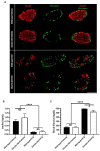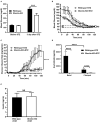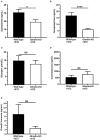Ghrelin Protects Against Insulin-Induced Hypoglycemia in a Mouse Model of Type 1 Diabetes Mellitus
- PMID: 33042003
- PMCID: PMC7518392
- DOI: 10.3389/fendo.2020.00606
Ghrelin Protects Against Insulin-Induced Hypoglycemia in a Mouse Model of Type 1 Diabetes Mellitus
Abstract
Insulin-induced hypoglycemia is a major limiting factor in maintaining optimal blood glucose in patients with type 1 diabetes and advanced type 2 diabetes. Luckily, a counterregulatory response (1) system exists to help minimize and reverse hypoglycemia, although more studies are needed to better characterize its components. Recently, we showed that the hormone ghrelin is permissive for the normal CRR to insulin-induced hypoglycemia when assessed in mice without diabetes. Here, we tested the hypothesis that ghrelin also is protective against insulin-induced hypoglycemia in the streptozotocin (2) mouse model of type 1 diabetes. STZ-treated ghrelin-knockout (KO) (3) mice as well as STZ-treated wild-type (WT) littermates were subjected to a low-dose hyperinsulinemic-hypoglycemic clamp procedure. The STZ-treated ghrelin-KO mice required a much higher glucose infusion rate than the STZ-treated WT mice. Also, the STZ-treated ghrelin-KO mice exhibited attenuated plasma epinephrine and norepinephrine responses to the insulin-induced hypoglycemia. Taken together, our data suggest that without ghrelin, STZ-treated mice modeling type 1 diabetes are unable to mount the usual CRR to insulin-induced hypoglycemia.
Keywords: ghrelin; glucose clamp; glucose counterregulation; hypoglycemia; type 1 diabetes.
Copyright © 2020 Shankar, Gupta, Mani, Findley, Osborne-Lawrence, Metzger, Liu, Berglund and Zigman.
Figures



Similar articles
-
Ghrelin does not impact the blunted counterregulatory response to recurrent hypoglycemia in mice.Front Endocrinol (Lausanne). 2023 Jun 2;14:1181856. doi: 10.3389/fendo.2023.1181856. eCollection 2023. Front Endocrinol (Lausanne). 2023. PMID: 37334290 Free PMC article.
-
Acyl-ghrelin Is Permissive for the Normal Counterregulatory Response to Insulin-Induced Hypoglycemia.Diabetes. 2020 Feb;69(2):228-237. doi: 10.2337/db19-0438. Epub 2019 Nov 4. Diabetes. 2020. PMID: 31685528 Free PMC article.
-
Glucocorticoid-deficient corticotropin-releasing hormone knockout mice maintain glucose requirements but not autonomic responses during repeated hypoglycemia.Am J Physiol Endocrinol Metab. 2006 Jul;291(1):E15-22. doi: 10.1152/ajpendo.00526.2005. Epub 2006 Jan 31. Am J Physiol Endocrinol Metab. 2006. PMID: 16449297 Free PMC article.
-
Hypoglycaemia: the limiting factor in the glycaemic management of Type I and Type II diabetes.Diabetologia. 2002 Jul;45(7):937-48. doi: 10.1007/s00125-002-0822-9. Epub 2002 Apr 26. Diabetologia. 2002. PMID: 12136392 Review.
-
Hierarchy of physiological responses to hypoglycemia: relevance to clinical hypoglycemia in type I (insulin dependent) diabetes mellitus.Horm Metab Res. 1997 Mar;29(3):92-6. doi: 10.1055/s-2007-978997. Horm Metab Res. 1997. PMID: 9137976 Review.
Cited by
-
"A LEAP 2 conclusions? Targeting the ghrelin system to treat obesity and diabetes".Mol Metab. 2021 Apr;46:101128. doi: 10.1016/j.molmet.2020.101128. Epub 2020 Nov 25. Mol Metab. 2021. PMID: 33246141 Free PMC article. Review.
-
Ghrelin cell-expressed insulin receptors mediate meal- and obesity-induced declines in plasma ghrelin.JCI Insight. 2021 Sep 2;6(18):e146983. doi: 10.1172/jci.insight.146983. JCI Insight. 2021. PMID: 34473648 Free PMC article.
-
Impact of Ghrelin on Islet Size in Nonpregnant and Pregnant Female Mice.Endocrinology. 2024 Apr 29;165(6):bqae048. doi: 10.1210/endocr/bqae048. Endocrinology. 2024. PMID: 38626085 Free PMC article.
-
Ghrelin deletion and conditional ghrelin cell ablation increase pancreatic islet size in mice.J Clin Invest. 2023 Dec 15;133(24):e169349. doi: 10.1172/JCI169349. J Clin Invest. 2023. PMID: 38099492 Free PMC article.
-
Germline and conditional ghrelin knockout increases islet size.J Clin Invest. 2023 Dec 15;133(24):e175799. doi: 10.1172/JCI175799. J Clin Invest. 2023. PMID: 38099493 Free PMC article.
References
-
- Cryer PE. Physiologic response to hypoglycemia in normal subjects and patients with diabetes mellitus. [Internet], (2015). Available online at: https://www.uptodate.com/contents/physiologic-response-to-hypoglycemia-i... (accessed October 26, 2015).
Publication types
MeSH terms
Substances
Grants and funding
LinkOut - more resources
Full Text Sources
Medical
Molecular Biology Databases
Research Materials

